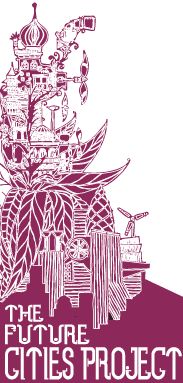Future Cities Project 2004-2005
In 2004 and 2005 I had the pleasure of working on the Future Cities Project, an initiative of the Sustainable Living Foundation that aimed to bring sustainability experts, environmental scientists, writers and artists together to collectively envisage what a sustainable city might look like in 50 years time.
Driven by the incredible Stephen Mushin, I worked on this project as art director, copywriter and designer. Here’s the guff from the project website:
The Future Cities Project is an exercise in intelligent dreaming. Scientific opinion flirts with imaginative play to create a series startling visions and intriguing possible future worlds. Each year at our Future Cities Forums in Melbourne, Australia, environmental thinkers, designers, artists, writers, illustrators, design students and primary children come together to play and dream. The project aims to encourage cross-disciplinary collaboration, and to engage the public to rediscover their own creative potential for making a sustainable future.
The results from collaborations over the last four years have included short stories, scientific opinion and articles, transcripts, illustrations, a DVD animation shown at ACMI and on the large screen at Federation Square and large-scale sculptural installations on Federation Square. In 2005, Future Cities Project workshops were conducted as a component of the RMIT Industrial Design curriculum and as part of a series of children’s design workshops during the Melbourne Fringe Festival’s Fringe Ideas Program.
Participants in the project have included: * Moss Cass (Australia’s first Federal Environment Minister) * Tricia Caswell (former Executive Director, Global Sustainability RMIT) * Joy Murphy Wandin (Aboriginal Elder of the Wurundjeri) * Melanie Ashton (Co-Chair of the International Youth Earth Charter Initiative) * Peter Newton (Science Director, Built Environment, CSIRO) * David Holmgren (Co-originator of the Permaculture concept and movement) * Michael Krockenberger (Strategies Director, Australian Conservation Foundation)
Over the last three years, sponsors and project partners have included: * Department of Sustainability and Environment * The City Of Melbourne * Global Sustainability @ RMIT * Melbourne Docklands * Victoria Harbour by Lend Lease * Drome Design * ACMI * Green Innovation
One of the outcomes of the project in 2005 was an experimental flash interface concept. It was conceived as a way of spatially representing the spread of ideas on sustainability and was, funnily enough, presented in the form of a city. It worked a little something like this:
In order to present a diverse range of ideas from a diverse range of participants, we’ve created an experimental web interface which uses content to build a virtual future city, where each building or icon represents an idea, image or story. Holding your mouse over an icon will display a brief summary of that element. Clicking an element will zoom you to that building, and the relevant content will load and be displayed. Have a play – we’re in the process of refining the concept. The current site includes nearly a hundred quotes, stories and articles, with more being added frequently.
Buildings and icons within our future city are positioned according to the type of sustainable future they describe. The X axis represents where they sit on a continuum from nature to technology: buildings at the far left represent ideas which emphasise sustainability through natural systems, a ‘back to nature’ approach and modifying human society to work within natural parameters. Buildings to the right contain visions of the future which emphasise technological solutions to environmental and social issues.
The Y-axis describes the way in which these approaches might be implemented, ranging from an organic, DIY, participatory approach at the bottom, through to a regulated, legislated and automated vision of sustainability at the top.
Using this system, the city naturally forms ‘neighbourhoods’ around certain approaches to the future. This in many ways replicates the actual processes of how cities evolve, with like-minded people grouping themselves together for common purposes.
The site was hosted by the Sustainable Living Festival up until 2007. It is no longer on-line, but at some point in the future it may be resurrected and developed further.
Base website: (via archive.org) Future Cities Project
